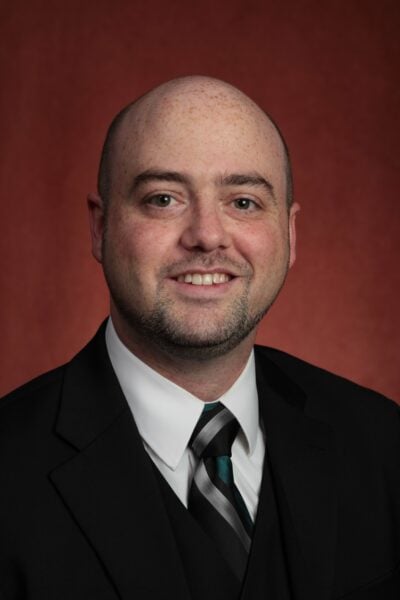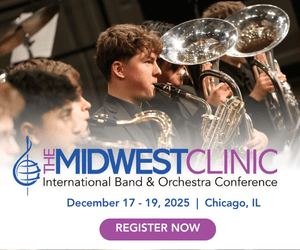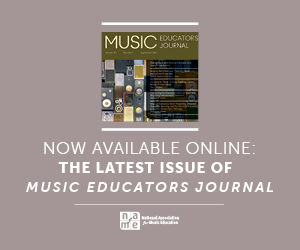/ News Posts / Applications for Impact: Comments from the Editor
Applications for Impact
Comments from the Editor
By NAfME Member Jason M. Silveira
This article first appeared in the February 2025 issue of Update: Applications of Research in Music Education.
I was recently speaking to some of my graduate students about the publication process, and they shared with me some of their questions and concerns about entering the field of higher education as educator-researchers. Of primary concern for them was not teaching undergraduate students or even navigating the somewhat delicate and complex socio-political structures that undergird the academy, but the process of preparing manuscripts for publication and submitting them for peer review. As one might expect, this concern and the resultant imposter phenomenon is fairly common especially among early career music teacher educators. Sims and Cassidy (2019) found that among early career university-level music educators, more than 70% reported having frequent or intense imposter feelings. As I was considering what I might write for this issue’s Editorial, I thought a reflection on how to help emerging university-level music educators successfully navigate the sometimes turbulent waters of publication in academe might be helpful. In keeping with the aims and scope of Update, I hope that this epistle provides tangible and accessible applications for those interested in conducting research and for those interested in reading and implementing research in their classrooms.
To be clear, this Editorial will not outline the research process per se. Instead, I offer two suggestions for early career researchers (and their advisors) to jumpstart the process. First, what does it take to submit a manuscript for consideration for publication (other than a completed manuscript, of course)? In the (abridged for cultural sensitivity) words of our friends from The Wizard of Oz:
Cowardly Lion:
What makes the flag on the mast to wave? Courage.
What makes the elephant charge his tusk in the misty mist or the dusky dusk?
What makes the muskrat guard his musk? Courage.
What makes the Sphinx the seventh Wonder? Courage.
What makes the dawn come up like THUNDER?! Courage.
What puts the “ape” in ape-ricot?
Whatta they got that I ain’t got?
Dorothy and Friends:
Courage!
Cowardly Lion:
You can say that again!
It takes courage to submit a manuscript not knowing what reviewers might say about your work. In my personal experience, most times I have received feedback it has been thoughtful, dispassionate, and has helped strengthen my manuscript. I am sure that we have all experienced somewhat stinging rebukes in our time though. I am recalling my experience with a recent reviewer’s commentary that was 17(!) pages in length . . . from one reviewer. That experience aside, the other two reviewers were complementary and offered targeted and implementable feedback to improve the manuscript. Surely, I am not the only author who has received the dreaded comment, “what you should have done was . . .” Despite the potential for the occasional unwanted—but justified—barb, or the unwanted—and uncorrectable—barb, the benefits of submission tend to outweigh any perceived costs.
During the last biennial NAfME meeting, the Update Editorial Board met as we do each biennium. As part of this meeting, we discussed suggestions to increase journal impact and manuscript submissions. There were two suggestions that were brought up at the meeting that I wanted to share with the readership in the hopes that it might be the motivating factor that inspires you to submit a manuscript to Update for the first time.
Consider submitting your unpublished thesis or dissertation to Update. If your (or your advisee’s) thesis or dissertation is still in ProQuest and has not yet been condensed for publication, maybe now is the time to begin that process. In a number of fields, only a moderate percentage of doctoral students had published a research article based on a reduction of their dissertation. For example, researchers have found the following percentage of doctoral students had published an article based on their dissertation: 29% in social work (Fabre, 2015), 24% in nursing (Kearney, 2017), 25% in pediatric medicine (Maynard et al., 2014), and 25% in psychology (Evans et al., 2018). Within the field of music education, Sims and Cassidy (2016) reported that among the music education faculty they surveyed, 70% “estimated that 50% or less of their doctoral students had published a research article based on their dissertation and 79% . . . estimated that less than 50% had published a practitioner article based on their dissertation” (p. 70). If you or one of your former advisees has not yet published their thesis or dissertation, please consider Update as a potential outlet for publication. Many in-service teachers and music teacher educators could benefit from the dissemination of your/your students’ work.
In addition, as a way to strengthen university and K–12 partnerships, consider a collaborative researcher-practitioner co-authorship between university and public-school partners. Whether you are a teacher educator or in-service music educator, developing a research-to-practice partnership relationship built on mutual curiosity can help to spur research questions that are at the forefront of many music teachers’ minds. About 10 years ago, I presented a session at my state music education conference entitled “Putting Research into Practice: Does Research Really Have the Potential to Make Things Better?” In this session, my co-presenter (also in higher education) and I engaged with several in-service teachers by posing the question, “What is one current challenge that you are facing in your classroom, in your teaching, in your district that research might help you with?” Subsequent guiding questions included:
- Where might you go (journals, databases, etc.) to find existing research related to the challenge you identified?
- What determination do you hope to make for your challenge?
- What change(s) might you implement based on your findings?
- What future study/follow-up might you conduct?
If you are an in-service teacher who is interested in engaging in collaborative research to implement in your classroom, you might begin by keeping and exchanging journals with colleagues and university faculty to identify concerns or research ideas of interest to you and your students. Evaluate current research findings and consult with other in-service teachers. All research begins with a question. What inspires your curiosity?
As you read the articles in this issue, I hope that they inspire you to consider submitting a manuscript to Update. Whether it will be your first submission or the next of many, I leave you with these venerable words from the Wizard of Oz himself, “You have plenty of courage, I am sure. All you need is confidence in yourself.”
References
Evans S. C., Amaro C. M., Herbert R., Blossom J. B., Roberts M. C. (2018). “Are you gonna publish that?” Peer-reviewed publication outcomes of doctoral dissertations in psychology. PLOS ONE, 13(2), Article e0192219.
Fabre A. (2015). Publication of pediatric medical dissertations in France. Archives de Pediatrie: Organe Officiel de la Societe Francaise de Pediatrie [Pediatric Archives: Official Organization of the French Pediatric Society], 22(8), 802–806.
Kearney M. H. (2017). Making dissertations publishable. Research in Nursing and Health, 40(1), 3–5.
Maynard B. R., Vaughn M. G., Sarteschi C. M., Berglund A. H. (2014). Social work dissertation research: Contributing to scholarly discourse or the file drawer? British Journal of Social Work, 44(4), 1045–1062.
Sims W. L., Cassidy J. W. (2016). The role of the dissertation in music education doctoral programs. Journal of Music Teacher Education, 25(3), 65–77.
Sims W. L., Cassidy J. W. (2019). Imposter phenomenon responses of early career music education faculty. Journal of Research in Music Education, 67(1), 45–61.
About the author:
Jason M. Silveira, Associate Professor of Music Education at the University of Oregon, is the Academic Editor of Update: Applications of Research in Music Education.
Interested in reprinting this article? Please review the reprint guidelines.
The National Association for Music Education (NAfME) provides a number of forums for the sharing of information and opinion, including blogs and postings on our website, articles and columns in our magazines and journals, and postings to our Amplify member portal. Unless specifically noted, the views expressed in these media do not necessarily represent the policy or views of the Association, its officers, or its employees.
Published Date
June 3, 2025
Category
- Preparation
- Research in Music Education
Copyright
June 3, 2025. © National Association for Music Education (NAfME.org)






